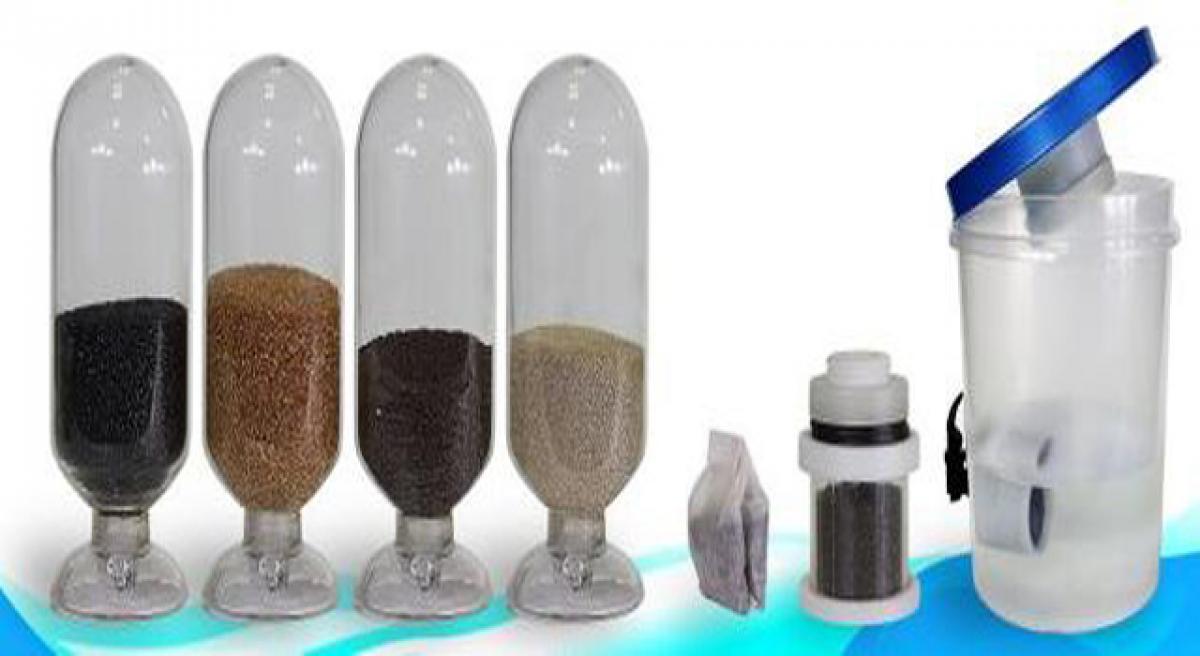Live
- Man smashes Ola scooter after receiving Rs 90,000 bill for repairs
- Ajit Pawar elected as leader of NCP in Maha Assembly
- Love, murder, cover-up: Married man kills live-in partner, sets body on fire
- Kishida launches new group within ruling LDP: Report
- Shreya Ghoshal to perform in 'Tripura Tourism Promo Fest'
- Congress lost its stature as brand, now just a regional party: Kangana
- Abu Dhabi T10: New York Strikers reflect on dominant bowling display in win over Bangla Tigers
- VHP Karnataka Resolves to Oppose Alleged Land Encroachments Under Wakf Board
- Formula 1: Verstappen claims fourth drivers' title as Russell leads Mercedes 1-2 in Las Vegas
- Air quality in Kolkata, Howrah deteriorates
Just In

A water filter for removing arsenic developed at IIT-Madras received much publicity recently, but some experts are sceptical about the claims made.
Bengaluru: A water filter for removing arsenic developed at IIT-Madras received much publicity recently, but some experts are sceptical about the claims made.
They urge decision-makers to become aware of the limitations of these devices before hastening to install them on a massive scale using public funds.
Arsenic is toxic even at very low doses. Millions of people in India and Bangladesh are exposed to high levels of arsenic through groundwater used for drinking.
Indian Institute of Technology-Madras (IIT-M) chemist Thalappil Pradeep has claimed that his filter delivers arsenic-free water at five paise per liter.
It uses a purification system that employs silver nanoparticles trapped in tiny "cages" made of chitosan -- a biomaterial derived from the shells of crabs and lobsters.
"The claims made in the press articles are amazing," Ashok Gadgil, Distinguished Chair of Safe Water and Sanitation, and Professor of Civil and Environmental Engineering at the University of California-Berkeley, told this correspondent in an email.
"If these claims are correct, the arsenic problem may be considered solved. But I am not considering the claims validated until there is transparency and integrity that come with multiple high-quality peer-reviewed papers," Gadgil added.
Sabyasachi Sarkar, a former chemistry professor at IIT-Kanpur, whose team had developed and patented such a filter in 2009, agreed. "Initially it may work for a few liters of water but sustaining it for days and safe disposal of the used filter are big challenges," Sarkar said.
Assuming a modest arsenic concentration of three milligrams in one liter of ground water, the IIT-M "community filter" daily supplying 10,000 liters of drinking water will be loaded with three kg of arsenic in around three months, clogging it, Sarkar said. "Where will the used filter loaded with arsenic be dumped?"
If smaller versions of the filter, distributed to households, are randomly thrown away after use (like people now do with used batteries) they will pollute the local soil with more arsenic. "This will be consumed by people via vegetables grown in such infected soil," Sarkar said.
"Undoubtedly, disposal of sludge rich in arsenic is a big problem," noted Dipankar Chakraborti, former Director, the School of Environmental Studies at Jadavpur University, who has studied the arsenic problem for three decades. "I do not know how the IIT-Madras project is taking care of it."
Developer Pradeep, in an email, dismissed these fears. "We can safely dispose of the used cartridges, as they do not leach out arsenic at the conditions of the soil," he said -- a claim challenged by Gadgil.
Quoting published studies Gadgil pointed out that "if the used filters are disposed in a garbage pit, the anoxic (low oxygen) conditions in the dump can leach out arsenic."
Pradeep's other claims that "in no case do the filters get clogged" and that the life of the cartridge can be "enhanced by reactivating" the composite by a simple heat treatment or "using a few drops of lemon juice" are also disputed.
Dissolved iron, commonly seen along with arsenic in the groundwater, precipitates during filtration and can easily clog the filters over long term, said Gadgil.
"Reactivation" by heat treatment is a "very, very" dangerous proposal, Sarkar said, due to the possibility of arsenic oxide in the filter getting reduced to elemental arsenic that can vaporise and get deposited everywhere.
"Activation by lemon juice is simple black magic and no chemistry," he added. "The claim is a hoax."
Another problem with the IIT filter, according to Sarkar, is that arsenic-infected water also contains heavy metal ions, pesticides, fungicides, hydrocarbons and microbes all of which -- along with arsenic -- will accumulate in the filter.
"The organic debris, with the help of microbes catalysed by metal ions, may trigger unforeseen biochemical reactions inside the filter, resulting in the release of toxic derivatives into the filtered water -- creating a newer health hazard," Sarkar said.
Noting that the key material used in the IIT filter is chitosan, Gadgil wondered if there will be enough of this to produce filter material to meet the daily drinking water needs of about 70 million people.
According to Gadgil, the five-paise-per-litre cost of the IIT-M filter may be deceptive as this does not include the cost of handling toxic sludge, maintenance, quality control and the like.
"So far about 15 types of filters have come to market and all claimed success at the beginning but, in course of time, they disappeared," Chakraborti said.

© 2024 Hyderabad Media House Limited/The Hans India. All rights reserved. Powered by hocalwire.com







